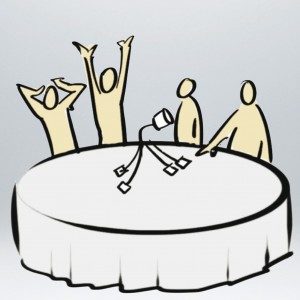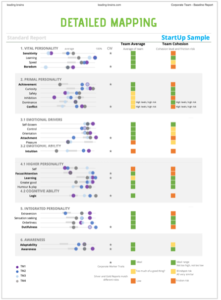Reading time: about 12 minutes
Many sports coaches know it – there are some team members, who may be unspectacular, but the whole team just functions better with them. But no one knows how to measure it and big data is not helping – or is it?

The standard logic in business and sports is that to get high-performing teams you should hire a bunch of high-performing individuals or even stars. In the sports world we are fascinated by this with fantasy teams of the best-ever teams of the best-ever players.
But the problem is that team performance is more than just the sum of the parts. For those who are familiar with rugby, which may not be many of you, every four years there is what is known as the British and Irish Lions tour. This is an old tradition and is considered one of the pinnacles of a rugby career – to play for and win with the Lions or play against and beat the Lions. In some ways more important and illustrious than the more recently introduced World Cup.
The fascinating thing is that logically the British and Irish Lions should thrash any team they come across. The players are selected from four of the biggest and most talented rugby nations on the planet (England, Scotland, Wales, and Ireland). So, picking the most talented players from a talent pool four times the size for any national team should provide an extremely talented team. And yet, despite this, the Lions winning against another national team is a big thing and far from a foregone conclusion.
They selectively tour one of the southern hemisphere countries: South Africa, Australia, or New Zealand. On balance their chance of winning is only about 50/50 probability similar to if any one of the national teams were to independently tour. What’s more, as part of the Lions tour, they also play club or provincial teams – teams a step down on the pecking order of a national team and yet, surprisingly, maybe, they do not win all the time, or rather, they lose regularly.
This shows that despite having rich pickings of talent from four elite national teams they do not necessarily perform better than any one national team and still fail to beat lowly club teams.
The question is why not, and what is the difference?
Another question is that of the unspectacular person on the team who somehow enables high team performance. In his insightful article ‘The No-Stats All-Star’ in The New York Times Magazine in 2009, Michael Lewis captured the essence of the problem. Writing about the US National Basketball Association (NBA) player Shane Battier, he notes:
Here we have a basketball mystery: a player is widely regarded inside the NBA as, at best, a replaceable cog in a machine driven by superstars. And yet every team he has ever played on has acquired some magical ability to win.
The above story of Battier is fascinating because he was consistently classed as an underperformer, and quoted as “at best a marginal N.B.A. player”. His stats on the things that N.B.A. teams measure such as points and rebounds, were terrible. On paper he was a massive underperformer, but somehow when he was on the field everyone else performed better. The article that the above quote is taken from goes into a lot more depth on the refinement of statistical approaches and under some of these characteristics, or rather, better forms of statistical analysis, Battier does show up. For example, the greatest players all under perform when guarded by Battier. This may makes good reading for another article on statistical analysis or what we quoted in the previous article of “you don’t get answers to questions you don’t ask” or my concept of non-information.
There are now a number of issues to approach in the above examples.
-
- Groups of higher performers do not necessarily (and often don’t) make high performing teams.
- And that unspectacular performers, to the external eye, and to most statistical analysis, can enable teams to perform much better.
The question now in business, is how can we identify these, and can we reward them also? Or simpler how can we put together high-performing teams. And more than that how do we define “talent”?
 Some of the clues may come in series of experiments on creativity. Tom Wujec is well known for his Ted talk on creativity using spaghetti and a marshmallow (a fun activity by the way) – the short video is well worth watching. The insights from these tasks are worth paying attention to. Notable is that kindergarten children were very effective but took a completely different approach to problem solving – worth saving for future articles on creativity – MBA graduates were terrible, and CEOs were also unspectacular.
Some of the clues may come in series of experiments on creativity. Tom Wujec is well known for his Ted talk on creativity using spaghetti and a marshmallow (a fun activity by the way) – the short video is well worth watching. The insights from these tasks are worth paying attention to. Notable is that kindergarten children were very effective but took a completely different approach to problem solving – worth saving for future articles on creativity – MBA graduates were terrible, and CEOs were also unspectacular.
Now let’s assume for the sake of argument, and there could be a lot of argument, that CEO’s and MBA graduates represent “talent”. Now not strictly true as Tom noted, thankfully, architects and engineers performed best and so were the most “talented”, giving thankful support, for the concept of being “an expert”. The CEOs and MBAs were ineffective because of using the wrong strategies – this is simply the problem of throwing a bunch of talented people together without thinking of team composition or what is known as complementarity. The insightful observation from Tom was that when he added an executive assistant to the teams of CEOs, their performance increased dramatically. Why?
He noted that communication and moderation increased. So, having a coordinator and communicator helped complementarity, and improved synchrony, another important facet of team performance. The assistants effectively functioned as enablers – similar to what Battier was doing – not worrying about their statistical performance but enabling others to perform better through managing communication and presumably also conflict effectively.
This is also neatly complemented by research into intelligence and collective problem solving by Woolley and colleagues: in a set of structured experiments teams were given collective problems solving tasks – tasks that required the team to solve a problem collectively. The outcome was that the team with the average highest IQ i.e. team packed with “talent” did not perform best, nor did the team with the person with the highest IQ, the top performer condition. So, who came out on top? The team with the best communication abilities, ability to listen and complement and interact with other people’s ideas. This again supports the concept of communication and enabling as being key factors to team performance. Women are more than interested to know that also simply having women in the team improved performance (of course you women knew that all along, didn’t you)!
There is more to team performance, the above is in collective problem-solving scenarios, which is not necessarily what every team is mandated to do, though arguably will always be a part of any team’s performance. Some of the other factors are not the focus of this article (see box at end). In summary team performance is very strongly influenced by other factors such as having a clear team, having clear roles, and clear goals. When I review teams in organisations, normally, this is the first thing I look at, and more often than not, the first thing that is wrong.
 But in the case of Battier and the marshmallow exercise these were already given: the team was clear and the team goals also. But an important aspect of the research, often glossed over, is that individual competence was a predictor of individual productivity, but inter-team support was a better predictor of team productivity. Simply put, helping others in the team enables the team to perform better. This also points to a word of warning to those arrogant high performers. Though they may individually perform well, the question is how much do they diminish the performance of others? In sales teams, which are often loosely bundled teams, arrogant high performers may do little damage and create a lot of profit, but for interdisciplinary teams looking to create new solutions, the team damage is likely to override their individual ability.
But in the case of Battier and the marshmallow exercise these were already given: the team was clear and the team goals also. But an important aspect of the research, often glossed over, is that individual competence was a predictor of individual productivity, but inter-team support was a better predictor of team productivity. Simply put, helping others in the team enables the team to perform better. This also points to a word of warning to those arrogant high performers. Though they may individually perform well, the question is how much do they diminish the performance of others? In sales teams, which are often loosely bundled teams, arrogant high performers may do little damage and create a lot of profit, but for interdisciplinary teams looking to create new solutions, the team damage is likely to override their individual ability.
This, however, doesn’t lead us into any insights of how to actually identify these people or team dynamics – obviously the intuitive amongst us will already have identified this and may make better decisions on team fit and include this in hiring decisions. But some research (unpublished) we did on successful and failed teams in the startup space gives us some intriguing theories of team performance. This could also give us better analytics such as in the example of Battier that showed with standard analytics he was an underperformer but when using more refined methods he was an exceptional performer.
We only measured personality with a view in our first mandate to give some ideas of how well-matched startup teams were. The reason for our first piece of research into this was the acknowledged importance of the team in enabling startups to succeed but an inability or unwillingness to measure this. So, what did our research show?
First off, we looked at the concept of homophily. This is the concept that similar personalities get on well with each other. We set some cut-off points and first off, we could see that areas of conflict that we predicted with high variation in personality, was well-supported.
 However, there is a problem with this because of the two concepts I mentioned previously. Namely synchrony can be seen as how similar in personality, or mindset, individuals are, but complementarity is the concept of having differing but complementary skills or personality traits. These are seemingly contrasting aspects. Though many leaders proudly claim they have diverse teams, our research shows they are not as diverse as they like to think, because they may be similar in multiple aspects of personality. Before I digress too far, I am sure you are keen to learn of what else we discovered in personality and effective teams.
However, there is a problem with this because of the two concepts I mentioned previously. Namely synchrony can be seen as how similar in personality, or mindset, individuals are, but complementarity is the concept of having differing but complementary skills or personality traits. These are seemingly contrasting aspects. Though many leaders proudly claim they have diverse teams, our research shows they are not as diverse as they like to think, because they may be similar in multiple aspects of personality. Before I digress too far, I am sure you are keen to learn of what else we discovered in personality and effective teams.
Well, we found that:
-
- Similarity in personality predicted cohesion
- Differences in personality were well accepted best when only in limited areas. So, the larger the differences, and the larger the number of traits that differed, the worse the team cohesion.
- Extreme differences can cause conflict particularly when in multiple areas.
- Polarisation was an important aspect of team conflict i.e. when two members were high in a trait and another very low.
- Individualisation of polarisation – when a single person is an outlier it can lead to this person being left out, when it is multiple this person can be totally polarised.
- Large variations, if evenly distributed, can lead to cohesion but slow decision making. So, the opposite of homophily when there is wide but nicely distributed spread there may be some underlying conflict, but everyone balances each other out. Complementarity in short
- Mindset caused large disruptions. For example, we mapped team members to corporate mindset, based on traits that support classic corporate thinking, and startup mindset, and this was very predictive of conflict and team breakup in the startup scenarios.
- Some traits seemed more predictive than others e.g. multiple personalities high on dominance was a recipe for conflict
- “Typing” (such as classic personality assessment humanistic vs. cognitive types) is too general and much less effective than including multiple different single traits
From this we developed a coherence figure including the above multiple inputs – but this can only be understood as a rough guide to team cohesion because a team has many moving parts. Roles, as we said, play a key importance and being effective in roles is critical for cohesion and conflict minimisation – we don’t measure this. Similarly, leadership and reporting structures will also guide potential for conflict.
What we also found, however, is that there are also moderating traits that minimise the risk of conflict. These includes, openness, and humour and those individuals who are high in intuition and high in cognition, helping to mitigate between these two contrasting viewpoints.
With the question of how to identify those average performers who enable high performance, let me show you what happens when we remove one person from a team.
Here you can see two teams along two separate personality traits (note that we measure up to 72 personality traits with our HBF tool – but normally only 28 for team cohesion). What you can see is a distribution of personalities along a scale. This team is therefore, based on this one trait, likely to differ significantly in how they approach problems and see the world but there are a range of personalities so there are those in the middle who will moderate others and act as communicators between the two. Decision-making may be slow but could be effective.
Team with balanced personality distribution
However, if we move one person out of the team, in each case the middle person, we now suddenly have a polarized team with two groupings and high and low ends of the scale. Polarisation was one of the biggest predictors in our data for team conflict. So, by removing one person from the team we have now created the potential for more conflict. This could therefore be the unspectacular performer who unbeknownst to others helps moderate conflict.
Team with moderating personality removed and with increased polarisation
The level of polarisation in the above is not extreme, here another example from the real world with very high polarisation:
A highly polarised team
So where does this leave us? Let me summarise
-
- A collection of talent or high performers does not make a high performing team
- Synchrony and complementarity are critical to team performance
- These can be measured and mapped but never are
- Communication skills are critical
- The team leader is responsible for managing this complementarity and synchrony
- Personality awareness can improve synchrony and complementarity
- Level of inter-team support is predictive of team performance
- Don’t forget the other obvious factors such as clear roles and clear goals
In short, when looking to build high-performing teams look to high synchrony and high complementarity (over, and with, “high talent”), measure this, build awareness, encourage open communication. And, food for another article another day, you need a team leader who can manage and lead this effectively.
The corporate problem is that many organisations seem unaware of these team performance issues, still focusing on getting “talent” and measuring individual performance. A question to ask, is how to measure, and value team performers, and how do you reward those individuals who may be unspectacular but somehow keep the team rolling? A good start is to measure team cohesion but also to identify those who are the enablers in the team and have high inter-team behaviours – they may be worth a lot more than you think●
Research into team performance
Research into team performance is long but notoriously difficult to research with so many moving parts in the real world. The military has provided the basis for a bunch of research because of their clear structure of teams and clear goals.
Some of the interesting and often underrated factors that come out of this research is: first off do you actually have a team? A team must be a coherent unit, stable overtime, have interdependences and have collective goals. Everyone agrees on that, but different researchers define them differently.
Similarly, the boring stuff is very important – clear roles and clear goals and the skills to perform the tasks. Nothing spectacular there but in modern matrixed global organisations, roles and responsibilities can become diffuse and large, with people wearing many hats.
Other more recent work that has become a main stock of team workshops has been the well-known work done by Google internally finding, to their surprise, but not to any psychologist or sociologist, that psychological safety was a key factor, as was leadership and particularly coaching by the team leader.
Context plays a role and the synchrony effect we speak about in the article is highest when teams have less well-defined roles and high interdependencies, but with less interdependencies and very structured roles, is less important. Similarly, synchrony has been shown to predict short-term success in entrepreneurial settings but complementarity, diversity, has been shown to be better for long-term success.
Using HBF to measure team cohesion
We specifically developed the HBF to measure team cohesion. Our report shows cohesion factors, blindspot risks where synchrony is high, but also friction risk where personality diversity is high. These are only potential risks, and managing them is up to the team. The report therefore provides a valuable way to frame this information and provide a basis to build awareness and discussions around how to improve team efficacy.

Detailed Mapping: Overview of how all team members map on each personality trait. You can identify moderators and enablers here.
And again: Overconfidently underthinking: narcissism negatively predicts cognitive reflection
This is the title of a 2020 paper relating cognitive reflection to other personality traits. This is well worth a read, but they measure multiple forms of cognition, reflection, various forms of narcissism, impulsiveness, and overconfidence. The big take away though was that those high in grandiose narcissism, claim to enjoy engaging in cognitive tasks, but are massively high on overconfidence, and show lower reflective abilities and insight.
So those arrogant individuals who have a high regard for themselves and their superiority will tend to fall into thinking traps more often but be overconfident in their abilities to avoid them and be unable to acknowledge and think through how they could have made a better decision. Many people in business reading this will be slowly nodding their heads having come across many people like this…
Littrell, S., Fugelsang, J., and Risko, E. F. (2020). Overconfidently underthinking: narcissism negatively predicts cognitive reflection. Think. Reason. doi:10.1080/13546783.2019.1633404.

Andy Habermacher
Andy is author of leading brains Review, Neuroleadership, and multiple other books. He has been intensively involved in writing and research into neuroleadership and is considered one of Europe’s leading experts. He is also a well-known public speaker speaking on the brain and human behaviour.
Andy is also a masters athlete (middle distance running) and competes regularly at international competitions (and holds a few national records in his age category).
References
Referenced articles
https://www.nytimes.com/2009/02/15/magazine/15Battier-t.html
https://aeon.co/essays/what-complexity-science-says-about-what-makes-a-winning-team
Team performance
Burke, C.S. et al., 2006. What type of leadership behaviors are functional in teams? A meta-analysis. Leadership Quarterly.
Ceri-Booms, M., Curşeu, P.L. & Oerlemans, L.A.G., 2017. Task and person-focused leadership behaviors and team performance: A meta-analysis. Human Resource Management Review.
Charan, R., Drotter, S. & Noel, J., 2011. The Leadership Pipeline: How to build the leadership powered company 2nd ed., San Francisco: Jossey-Boss.
Coutu, D., 2009. Why Teams Don’t Work–An Interview with J. Richard Hackman. Harvard Business Review.
Google (2019). Guide: Understand Team Effectiveness. re:Work https://rework.withgoogle.com. doi:.1037//0033-2909.I26.1.78.
Gully, S.M. et al., 2002. A meta-analysis of team-efficacy, potency, and performance: Interdependence and level of analysis as moderators of observed relationships. Journal of Applied Psychology, 87(5), pp.819–832.
Hackman, J.R., 2002. A Real Team. In Harvard Business School Press.
Hackman, J.R. & Connor, M.O., 2004. What Makes for a Great Analytic Team? Individual vs. Team Approaches to Intelligence Analysis. Intelligence.
Kozlowski, S.W.J. & Bell, B.S., 2012. Work Groups and Teams in Organizations. In Handbook of Psychology, Second Edition. pp. 412–460.
Morgeson, F.P., DeRue, D.S. & Karam, E.P., 2010. Leadership in Teams: A Functional Approach to Understanding Leadership Structures and Processes. Journal of Management.
Creativity and Intelligence
Somech, A., and Drach-Zahavy, A. (2013). Translating Team Creativity to Innovation Implementation: The Role of Team Composition and Climate for Innovation. J. Manage. doi:10.1177/0149206310394187.
Woolley, A. W., Chabris, C. F., Pentland, A., Hashmi, N., and Malone, T. W. (2010). Evidence for a collective intelligence factor in the performance of human groups. Science 330, 686–688. doi:10.1126/science.1193147.
Wujec, T. (2010). The Marshmallow Challenge. Marshmallow Challenge- TED TALK.
Homophily, Synchrony, and Complementarity
Antonenko, P. D., Davis, R., Wang, J., and Celepkolu, M. (2019). On the Same Wavelength: Exploring Team Neurosynchrony in Undergraduate Dyads Solving a Cyberlearning Problem With Collaborative Scripts. Mind, Brain, Educ. doi:10.1111/mbe.12187.
Aven, B., and Hillmann, H. (2018). Structural role complementarity in entrepreneurial teams. Manage. Sci. doi:10.1287/mnsc.2017.2874.
Gompers, P. A., Huang, K., and Wang, S. Q. (2017). Homophily in Entrepreneurial Team Formation. SSRN Electron. J. doi:10.2139/ssrn.2973329.
Hu, J., and Judge, T. A. (2017). Leader-team complementarity: Exploring the interactive effects of leader personality traits and team power distance values on team processes and performance. J. Appl. Psychol. doi:10.1037/apl0000203.
McPherson, M., Smith-Lovin, L., and Cook, J. M. (2001). Birds of a feather: Homophily in social networks. Annu. Rev. Sociol. doi:10.1146/annurev.soc.27.1.415.
Mønster, D., Håkonsson, D. D., Eskildsen, J. K., and Wallot, S. (2016). Physiological evidence of interpersonal dynamics in a cooperative production task. Physiol. Behav. doi:10.1016/j.physbeh.2016.01.004.
Reinero, D. A., Dikker, S., and Van Bavel, J. J. (2021). Inter-brain synchrony in teams predicts collective performance. Soc. Cogn. Affect. Neurosci. doi:10.1093/scan/nsaa135.
Ruef, M., Aldrich, H. E., and Carter, N. M. (2003). The structure of founding teams: Homophily, strong ties, and isolation among U.S. entrepreneurs. Am. Sociol. Rev. doi:10.2307/1519766.
Smith, D. M. (2018). Collective Synchrony in Team Sports. ProQuest Diss. Theses.
Steffens, P., Terjesen, S., and Davidsson, P. (2012). Birds of a feather get lost together: New venture team composition and performance. Small Bus. Econ. doi:10.1007/s11187-011-9358-z.
More Business Brains Articles
New Drivers of Selfishness and Collaboration Discovered
New studies shed more light on some contradictions and drivers of selfishness and collaboration Reading time: about 6 minutes how babies of only a few months old scenes of nice behaviour, such as helping another person, and bad behaviour,...
Work in the Presence of Others Lowers Stress
Different areas of the brain are associated with empathy – this new research shows how brain regions synchronise to induce empathic responses.
Everyday Pleasures Improve Brain Performance
Different areas of the brain are associated with empathy – this new research shows how brain regions synchronise to induce empathic responses.
Brain Scans Show How to Coach and Inspire More Effectively
Different areas of the brain are associated with empathy – this new research shows how brain regions synchronise to induce empathic responses.
You’re Less Productive in the Afternoon – Especially on Fridays
Different areas of the brain are associated with empathy – this new research shows how brain regions synchronise to induce empathic responses.
The Motivational Paradox
We may think that high motivation is a good thing, and it is. But there are a number of paradoxes such as how motivation can lower ability, increase stress, and lose broad focus, and be difficult to manage.






